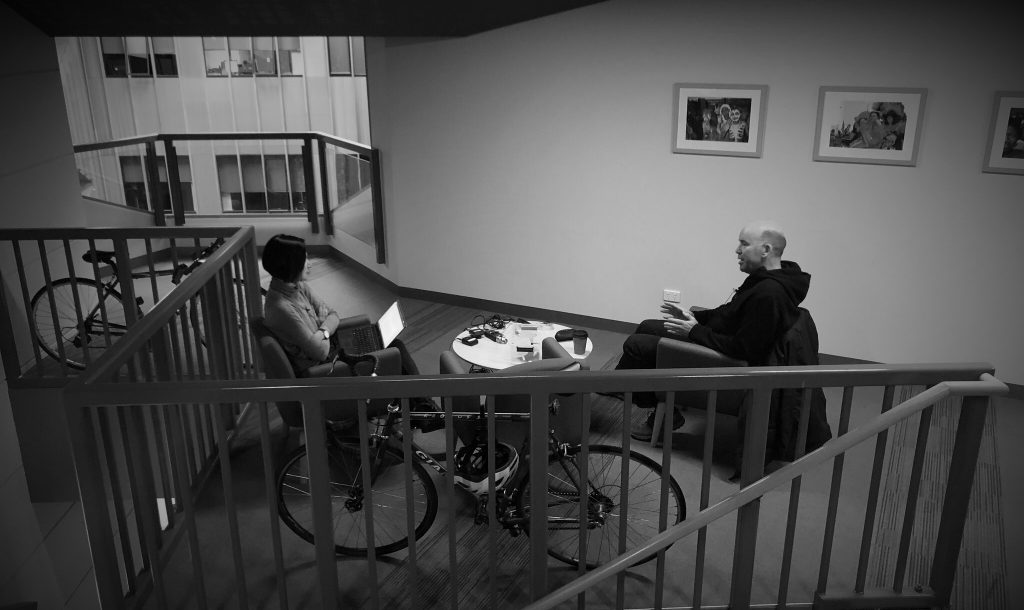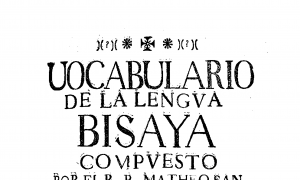Welcome to Part 3 of our special series of podcasts that take a look a The Philippines beyond the cliches. In this episode, New Mandala’s Philippines editor Dr Nicole Curato speaks with Dr Clarke Jones, a criminologist from the ANU’s Research School of Psychology. He talks about what his research inside the Philippines prison system reveals about the real-word effects of the belief that the Philippine state needs to be “tough on crime”. The transcript below was prepared by Bianca Ysabelle E. Franco from Ateneo de Manila University; note that it has been lightly edited for clarity and may at points differ from the recording.
Nicole Curato [NC]: Hello Clarke, welcome.
Clarke Jones [CJ]: Thanks very much.
NC: Alright, so the idea that the state needs to be tough on crime obviously is not unique to the Philippines. But before we do a deep dive on your work on the Philippine prison system, let’s first set the scene. I mean, what does it mean to be tough on crime? And why is this idea so appealing to so many people?
CJ: Well, it’s not just a problem to the Philippines. I think it’s a problem also in a lot of Western countries. Australia for example, United States, UK—and there’s been a very strong turnaround about being tough on crime which results in a high number of arrests, a high number of prosecutions and then of course the flow-on effect is large prison populations. And that’s probably my main concern and my main focus of my study is: what do you do with those increasing prison populations?
Now, the Philippines is a unique example because of the “tough on crime” particularly around drugs but also around terrorism. In the Philippines, the number of the cases on backlog now is around 700,000 pending cases, drug cases. With only around 1,400–1,500 lawyers to try and clear those cases through the courts.
Now, on its own that’s a bit of a crisis in itself. But when you consider that the prison population is already up to around, on average, 605% overcrowded—that’s incredibly overcrowded. You compare that to Australia where we can be over 100% overcrowded.
In one of the particular jails, Quezon City Jail, for example, the population is around 3,600% overcrowded. So, instead of having the ideal occupancy of around, in the Philippines, 1 to 4 per cell, you’ve got over 100 inmates in a cell. So, can you imagine: one toilet, inadequate washing facilities, food is scarce, and so you’re talking about sheer survival.
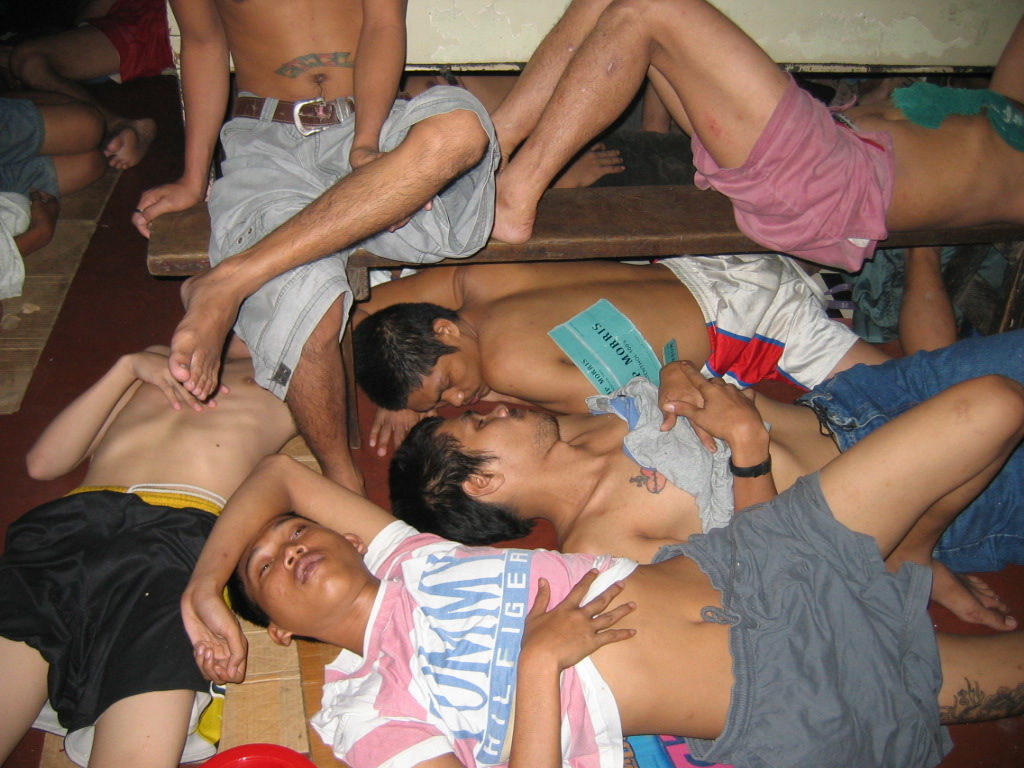
Extreme overcrowding in Quezon City Jail (Photo: Clarke Jones/Raymund Narag)
But what’s unique to the Philippines—if the same situation was in Australia or in a Western prison, there’d be mayhem. There’d be death, there’d be carnage, you know. And I’m not exaggerating. There’d be all sorts of problems. But the Philippines is a unique place. I mean: how do they deal and how do they cope? How do inmates cope with that level of congestion and that level of overcrowding? And it’s fascinating.
But getting back to the question about being “tough on crime”, at some point, and particularly in the Philippines, it’s going to reach an absolute crisis. What’s the tipping point of those prisons and jails? When can they no longer cope? What’s going to happen?
NC: Right. And I think what’s interesting about your work is you talk about the kinds of innovations that take place in the Philippine prison system given the limitations and resources, and you use the word shared governance in correctional management. And of course I’d like to share my most utmost admiration to the kind of work you’ve done. I mean, you’ve done ethnographic work in some of the most notorious prisons in the Philippines and one of your field sites is the New Bilibid Prison and for those who aren’t very familiar with Philippine context, it’s the most notorious penitentiary in the country and you’ve done—yeah, spent a lot of time working in this context. So, tell us about this research and what you’ve discovered about shared governance.
CJ: Well, just by way of background, we’ve spent—myself, and Dr Raymund Narag, we’ve spent—he spent longer but we’ve spent over ten years doing ethnographic—in other words, participant observation. So, we’ve spent time in prison, countless number of interviews with inmates, with gang leaders, with terrorist offenders, with prison and jail—sorry, I should say in this case prison officials.
So, sort of quite a cross section of people we’ve spoken to around the environment. We’ve also experienced the environment, which is really important. So I’m very critical of the fly-by-nighters who spent a day talking to an inmate and then they make observations about the prison.
We learn a new thing each time and it’s quite a fascinating environment. But also to provide some context: we’re talking about over 17 and a half thousand inmates in 9 square hectares in the maximum security prison. That’s huge. So, it’s like a micro city. You’ve got shops, restaurants, hamburger stores, arts and crafts stores, hardware stores, barbershops, a café. I can remember even having a silver service dinner provided by the Batang City Jail gang. And it’s one of the best meals I’ve ever had in the Philippines, actually.
NC: What did they serve? Out of curiosity. (laughs)
CJ: It was blackened tuna—
NC: Wow. (laughs)
CJ: —and it was other fish dishes and chicken and it was quite unique, and the inmates served.
So, at that point in time, I mean things changed but at that point in time, inmates were learning restaurant skills and cooking skills. And in fact, they ran a show called Iron Bar Chef. It was a cooking competition similar to Iron Chef on TV. So they took their cooking skills, but this was not provided by the prison. This was provided by the inmates, by the gangs. So, when you have too many inmates—so you’ve got one guard per eighty inmates—there’s not a lot of resources for the inmates. So, the inmates can either sit there and rot or they don’t.
Filipino inmates are quite unique in relation to their coping mechanisms to deal with what’s called the pains of imprisonment and their life inside. When we talk about life inside, it’s not like our life. Their life inside can be up to 45 years. And in maximum security, it’s basically from 20 years on.
Now, going into that sort of environment, we talk about “prisonisation”—in other words, people become institutionalised to the—in the Philippines, they do get institutionalised but when they get into prison, they don’t lose their skills, they don’t lose their identity, they don’t lose their family contact. So, they maintain their—if they’re a doctor, they stay a doctor—and they help within the hospital. If they’re an engineer, they go and help with the facilities in the building or the facilities. And there’s all sorts of trades.
Inmates also, there’s an inmate who was a colleague of Dr Narag and he developed a cafe, sort of restaurant in the Batang City Jail gang area. He now runs three cafes outside of the prison around Muntinlupa, which employs ex-inmates and ex-offenders and their families. So, this is not government funding. This is all about the inmates doing it and supporting themselves. They run computer training, computer workshops.
So, there’s a lot of positive sides. There’s also the negative sides. Because you know we talk about contraband—and you know, I’ve spent time in the military, and I’ve seen some pretty fancy weapons inside New Bilibid Prison. So, you know it’s not always good and then of course, as the President of the Philippines rightly observed, there was a lot of drug problems within the prison. I would argue that the shabu trade, the methamphetamine trade, in the Philippines was operated from inside the prison. And in the early days, and I’m talking early days, probably five or ten years ago, there were [that] I know of a couple of labs inside the prison. Now, they’re long gone, but…so there are two sides of this. One, there’s this incredible coping strategy and there’s also the illicit trade that goes on in prisons. After all, it is a prison full of offenders.
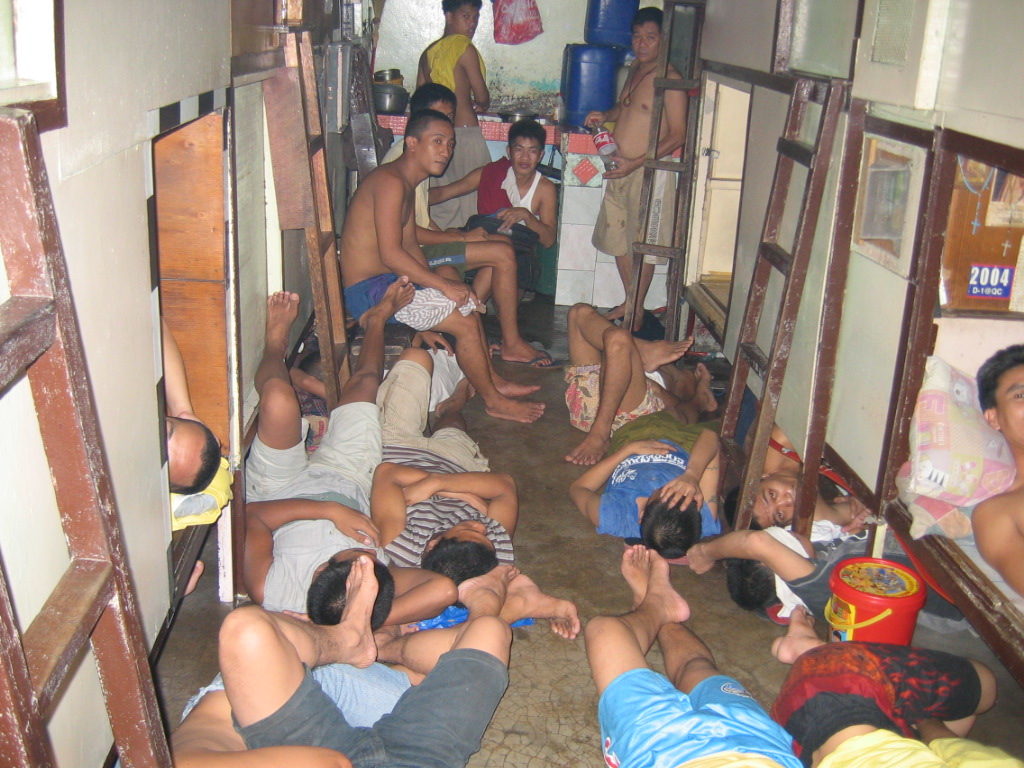
In Quezon City Jail, inmates construct ‘kubols’ (cubicles) to gain a small amount of personal space (Photo: Clarke Jones/Raymund Narag)
NC: Right. But I think the critics would obviously say that the problem here is that you put people in prison precisely to deprive them of their civil liberties. And the way you portrayed how they cope inside prison and to perform as if they’re productive members of society goes against that logic. Which I guess reminds us of this whole clamour for being tougher on crime, that these people shouldn’t be able to do this inside prison. So, what’s the rationale for this kind of model that from my reading, you’re kind of celebratory about?
CJ: Look, it is hard to understand that. But remember: they are deprived. They are locked away—mind you, if I could make my choice and if I was an offender and I had to spend time, I’d prefer to spend time in a Philippine prison than in an Australian prison. However, they are still deprived of liberty. They can’t simply leave the prison when they want. Although, they do work ways around that too, by the way. So, they are deprived of normal living.
But if we’re thinking about punishment, we’re thinking about what’s the point of prison, well, it should be around rehabilitation. Now, I would argue that there are more chances of rehabilitation in that open environment because it’s not all about rehabilitation programs. It’s also the ability to spend time with family [while incarcerated that increases their prospects of rehabilitation].
Now, up until Duterte came into the presidency, there was the ability for families to visit almost 7 days a week into the prison. Children were seeing—there was even a zoo inside the prison. There were playgrounds that were built by the inmates. So, the point I’m getting to is: the inmates still maintain family contact. Most inmates maintain family contact and were able to see their children. That has a massive effect.
Firstly, it limits the chances of family breaking down, but also, there’s lots of research to say that inclusion in family involvement during incarceration has strong positive rehabilitation effects. But also helps inmates readjust once they leave prison. So, the thing that’s always annoyed me in the Philippines is it’s always Western countries—the US, Australia, the UK, European countries as well—come into the Philippines and say: “This is how you should do it.” But our systems [of imprisonment] are failing [in terms of recidivism]. Our systems are probably failing more than the Philippines.
So, I would like one day for the Philippines, for the Philippine correctional system to go overseas and tell others how they do it. Because there are unique aspects that I sort of like in the Philippine correctional system—this might sound crazy; it shows you I probably have been in too long—but the Philippine system, [the] prison correctional system, is closer to the sort of Scandinavian prison systems which has the lowest recidivism rate in the world. Now, that’s because it’s an open prison system. Inmates can maintain their sense of identity, their skills. They still maintain their contact with family. Now, this is what happens in the Philippines. In the Philippines, it’s very cultural, though. Because you know sharing of food and family is critical for sense of identity and you know I love that about the prison system. So I’ll state that I’m not getting warm and fuzzy about prisoners. But what I am saying is: there’s got to be better ways of doing it. And what the Philippines does is not all bad. You know, if you want to but the corruption and the contraband and those things aside, there are some very positive things that happen.
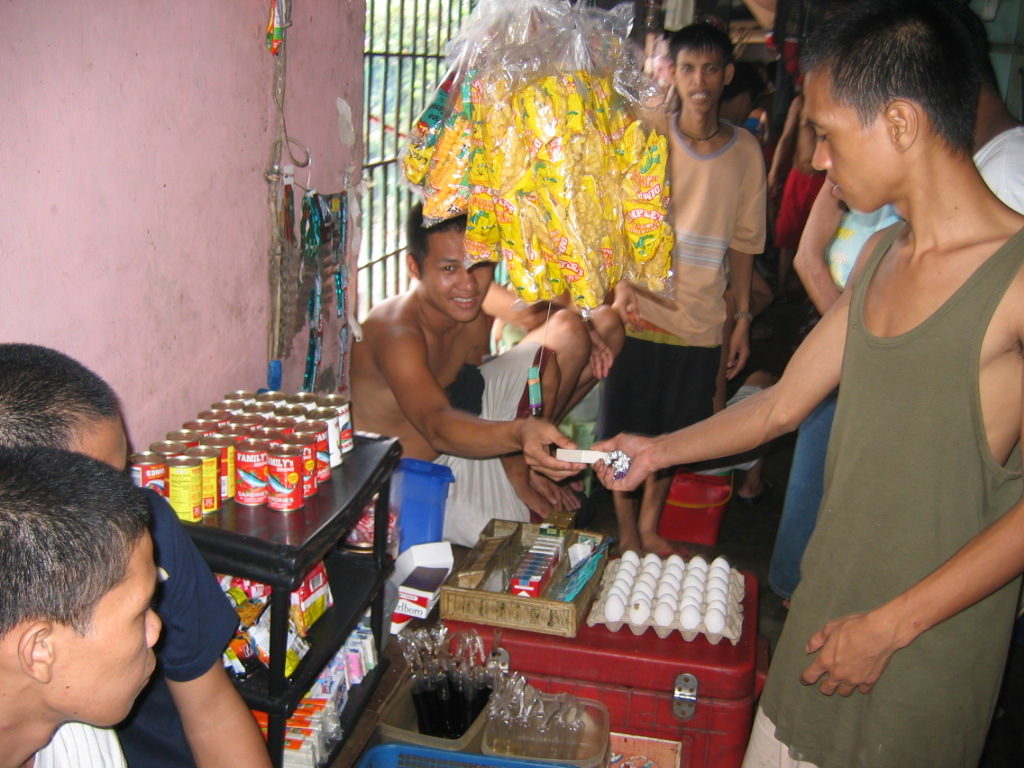
Inmates in New Bilibid Prison set up a small shop to sell basic necessities for other offenders (Photo: Clarke Jones/Raymund Narag)
NC: But of course, we are now in a very different context. We have a president who won based on the platform of being “tough on crime”. No shame about calling for the deaths of suspected criminals, how has that affected prison governance?
CJ: It’s had an incredible effect. And this is the real shame. So, I visited—I was there just before Christmas. I’ve been writing my book so I haven’t got back again but we’re soon to return. But, one thing we did notice on our last visit and another round of interviews with the usual suspects, the people that we have always had a relationship with over the last ten years or so, is [that] we have never seen so much strain on the faces of the inmates that we’ve talked to. So, what’s happened is now, the prison rather than the prison being run by Bureau of Corrections staff, it’s now run by the Special Action Force of the Philippine National Police. So, it’s like you know getting the SAS [Special Air Service] running the prison here in Australia. [The SAF] don’t have the skills to run a prison; they’re police. They’re elite police. So, you’re getting abuse happening, you’re getting—the coping mechanisms are being shut down, so, visitation—and I want to talk specifically about terrorist offenders, if their family’s going to come up from the south, up from Mindanao, they’re only allowed 20 minutes per month to see their loved ones inside.
NC: Compared to the previous context where how many hours to they get?
CJ: They could get as much contact as they want. You know, obviously there’s a lock down at night-time. Lock down in the Philippines is different from lock down in Australia or the US, but there was regular visitation. But now it’s almost—once you shut down that vital family support structure, you’re asking for a lot of trouble.
So if I can focus on terrorist offenders: where there was once very little sign of prison radicalisation or illicit activities happening inside, now I would argue the whole sentiment has changed, where there’s a high likelihood of increasing anger and leading to potential acts of violence from the inside. Because they’re not allowed those usual coping mechanisms. I mean, inmates will eventually adapt, but in the short term it’s incredible to see what’s happened. I’ve never seen—and we’ve spoke to two of the inmate leader groups within the Muslim inmates, and they weren’t happy people.
In fact, they’re likely to fight with each other. There’s two groups: one of them, they’re sort of the businessmen from Mindanao, the pearl farmers and pirated DVDs and different sorts of stuff, also other sort[s] of criminal offending. And then you’ve got the terrorist groups, Abu Sayyaf, MILF, and Jemaah Islamiyah—although there’s not many [of them] there now—and Maute group. But when you start to cut down that coping mechanisms, you start to get conflict between groups. You’ll also get conflict between the various gang leaders. So, frustration starts to build.
And this is the thing, out of all the years, there has only been one time where I have ever been threatened within the prison environment and that was my own stupidity when I took out my wallet to buy a painting by a Chinese drug dealer. And you know, I’ve never done the same mistake since. But all other times, there’s an element of respect and very strong gang rules that prevent—you know, visitors are very much protected. And once again, the only time I’ve seen a female visitor ever accosted was by an English inmate who jumped [her]—he was on his BMX bike and he was riding past and jumped [her] from his bike. He suffered the consequences. I won’t go into details there, but the inmates and the gangs have their own punishment systems. But there’s very strong rules. I would argue, they police themselves within the prison environment, not the guards. It’s just fascinating, and you know, from rules and control mechanisms on the positive side. But again, I stress there is a negative side to all this as well.
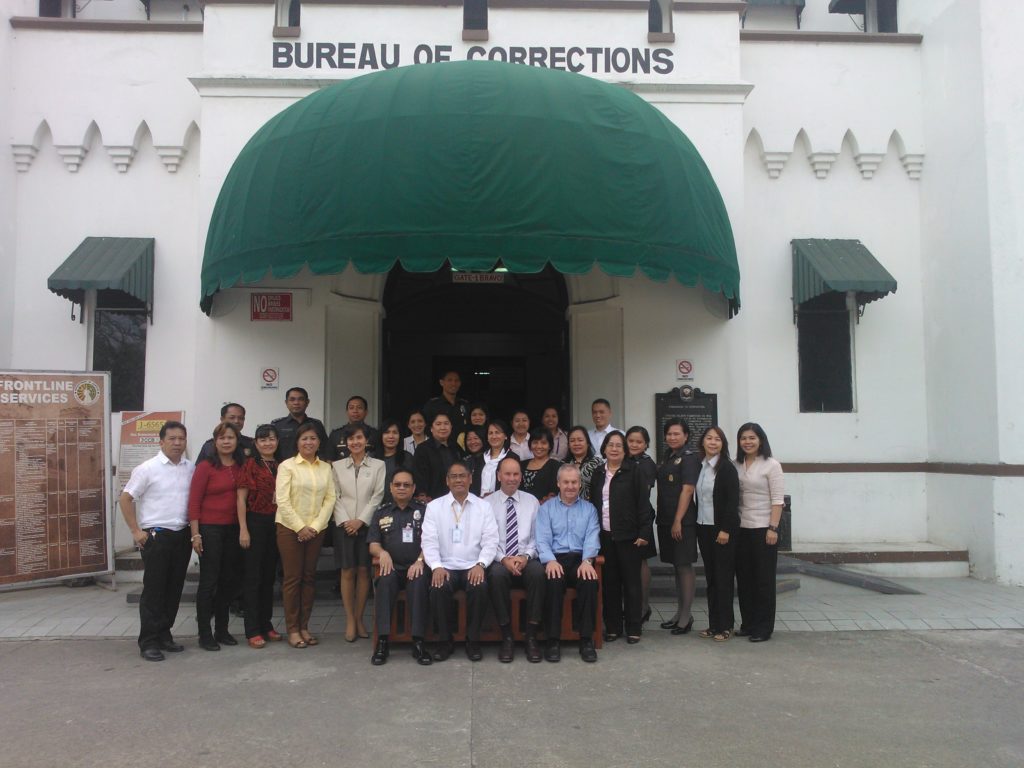
Dr Clarke Jones and Dr Raymund Narag with staff at the Bureau of Corrections at the New Bilibid Prison’s maximum security compound (Photo: Clarke Jones/Raymund Narag)
NC: And of course, I know you’re not in the business of prescribing what the Philippines should do when it comes to the prison system. But of course, there is also a lot of attention with the corruption scandals. This has been used as basis to delegitimise former Department of Justice Secretary and now Senator Leila De Lima. So I think the curiosity here from the governance perspective is while on the other hand there are positive aspects to allow inmates to have their own governance system, but on the other hand, you also I guess want a clear state structure to officially sanction or punish offenders within the prison system. So, where is the right balance here?
CJ: That’s a very good question. You know, if I was to put my finger on the biggest problem within the system—I mean overcrowding’s huge isn’t it—but: corruption.
Corruption has always been a major issue and I’ve seen corruption, and I don’t want to mention names, but I’ve seen corruption from the prison-level Bureau of Corrections staff through to the leadership. And we—I’m going to be careful here—we’ve known about and reported activity through the gangs. And if I talk about gangs, there’s always been twelve gangs. They were controlled by two chairmen which was the sort of the top dogs of the gangs. They each hand six gangs each. And these, they’ve been truly on TV and in Philippine media and I knew them very well.
NC: Did they make you listen to their CDs?
CJ: What’s that, sorry?
NC: Did they make you listen to their CDs?
CJ: Oh, well [one chairman] gave me his CD and I played it once at home and it was nearly divorce, put it that way.
NC: (laughs)
CJ: But it… you know, look, I mean I say on one side, it’s great that he was producing music and he was a real, you know, character if I could put it that way. And then [the other chairman] had his own TV studio and I mentioned the Iron Bar Chef but they also had one program called New Bilibid’s Got Talent, which is singing and different sorts of programs. But he did a lot of filming and involved inmates in learning about movie[s] and videos and all that sort of stuff so there were some positive aspects to that too.
But, however, [that chairman] through the Sigue-Sigue Commando gang provided a lot of the protection for the Chinese drug lords and Chinese drug markets. He may have said otherwise but he—I never saw him actively involved in—I don’t want to incriminate him in any way but I never saw any—you know, I knew a very personal side of him as well as his family background and his upbringing and you know, as a criminologist, I need to sort of understand the way people got to where they are. But he had a—I won’t go to the gruesome aspects of his record. [The other chairman], on the other hand was a… you know, he may have been—allegations are that he was more heavily involved in the drug market.
Going back in a little bit of story, so I’ll get to the corruption bit but eventually a Secretary de Lima came in and had the 19 drug lords isolated in Building 14 which is the isolation part of New Bilibid Prison. But [one of the chairmen] stayed outside. He wasn’t included in that. So, there’s two schools of thought to that. And the Secretary De Lima has been alleged [to have been] part of that. And you know, I probably shouldn’t say anything either way but you know, I respected what she was trying to do and I saw some really positive sides to the prison system as a result of her work. However, it was I think some of her staff that got involved in with that leadership structure and that’s where the sort of allegations became more solid, if I can put it that way in relation to proceedings.
So, you can crackdown or you can say: “well the gang system is at fault in relation to the drug industry and they’re the ones who were promoting the corruption”. But I think the whole drug market was facilitated from both ends: from the staff in the prison as well as the guards. And corruption was the most—it was the biggest problem in the whole prison system. At one point in time, when [one person] who was head of the Bureau of Corrections was there [at New Bilibid Prison], we were looking at alternative income streams because one of the biggest problems with corruption with guards and money that comes from the drug market within the prison is the social service aspect of it. Now, we don’t think about [that]—we think about the criminal aspect. But the money from the drug market, a lot of it used to go to pay for families.
So, once you take away the drug market, which was an important thing—they had to do something about the drugs and I do commend the president in one sense for his hard line on drugs. Something had to happen; it was in a bit of a crisis perspective—but if you take away the money from the drug market, what we’re trying to do is create alternative income streams by increasing manufacturing within the prison system by trying to look for alternative money to support the inmates, to support the families. But even when we try to do that, and I’ll give you an example, a Australian company, a wooden toy manufacturing company, we tried to get established within the prison. But the gangs wanted 30%; the guards wanted a percentage. And it just was not viable for the Australian company so that sort of idea about trying to—because corruption is a big thing.
Everything gets skimmed. Money gets skimmed off the food rations, the money that comes in for food from the government. Money gets skimmed off for the guards. If an inmate wants to move from one place to another, the inmates take—sorry, the guards take money from them. Everything’s on a cash-based system. And sometimes, officers don’t want to be promoted because they want to stay in the position they’ve got because that’s the most place where they’re going to get the money. So, I remember one guard told me: “everyone’s got to have a second job”. What he means by that is they get so little pay that they’ve got to look for—you know, there’s not enough money for them to do their job and then support their families. They’ve got to have extra income.
That said, the government has done a very positive thing and with the BuCor Modernisation Act [The Bureau of Corrections Act of 2013] and the BJMP [Bureau of Jail Management and Penology] staff have now recently got a fairly significant pay increase. Let’s hope that that’s a positive step in moving in the right direction.
But you know, I think corruption is a very cultural thing. When Secretary De Lima was in there [running the Department of Justice], we did start an anti-corruption course with prison staff about not going into police them or catch people out but we went in there to try and get them to talk about and let them know that we know about those sorts of practices. And looking about creating strategies for slow change, to look at alternative ways of doing things. Because if you go in there, and like the president’s just done, and shut things down, you get resistance and fighting. The programs never become sustainable. It just won’t work, there’s too much opposition. So, you know, if there’s going to be change in the Philippine correctional system, it needs to be done slowly.
NC: It just sounds so delicate in a way because on one hand, of course, we know the problems of corruption in the Philippine prison system. But on the other hand, it feels like it is what underpins the social order of this highly problematic system that’s overcrowded, that’s very divided, that has an unprofessional system. So it feels like it’s like what you said, it’s just very much hanging on the balance, you know. And it has to be—you can’t just have abrupt changes because it will just break it.
CJ: Yeah, exactly. How do you eat an elephant? Bite by bite. It’s the same thing, you know. And even the work Dr Narag and I are doing at the moment with BJMP in particular is not about drastic changes. It’s about—you know, if we’re talking about changing the structure or amalgamating jails or whatever we might be doing, it’s not about coming in and saying the Western way of doing things. You need to be very culturally specific in how you do things. You’ve got to work with what you’ve got. You can’t work against it.
And over the last 10 years, the amount, or the millions of dollars I’ve seen being donated to the Philippine government from Western governments on how to change the prison system—it’s being wasted. You know, I say that very strongly. I’ve seen so much training where they select the staff not based on who needs to do the course because that’s the area they’re working in, it’s who needs a pat on the back and some sort of motivation, you know. They don’t select the right people. And I’m not getting the words out properly there, but the point is: the money is getting wasted. So anything that needs to be done now, it needs to be sustainable, you need to work with what you’ve got, and the change needs to be slow, very slow.
And what I’m suggesting and what we’re doing is we don’t only engage the prison staff, we also engage the inmates. Because they’re the ones that create the opposition, they’re the force in numbers. We need to engage and this is why we talk about shared governance. It’s very much a shared governance model. In other words, they’re also in charge. They do the headcounts, they’ve got the keys. They’ve got all these things in the prison system—which is crazy if you’re from a Western prison system, to think that that’s the case—but they’ve got their own sort of policing systems. Now, you need to work with that. That’s not going to change.
Philippines beyond clichés series 1 #1: Catholic country
Jayeel Cornelio talks to Nicole Curato about the under-appreciated level of religious diversity in the Philippines.
NC: Which I guess brings us to the end of this podcast in terms of summarising just all the ideas you put forward in this discussion and I think it’s a good summary, in a way, ending on that note. That when we talk about the Philippines needing to be tougher on crime, well, we just have to turn back to your work and talk about how being tough doesn’t necessarily mean proper governance. So, in summary, Clarke, can you tell us your comments on the stereotype, the Philippines needs to be tough on crime?
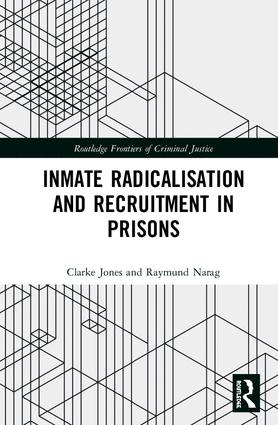
Clarke Jones & Raymond E Narag, “Inmate Radicalisation and Recruitment in Prisons” (Routledge, 2018)
CJ: I think the Philippines needs to look to alternatives to “tough on crime”. In other words, what is happening within society that’s generating the drug market or generating the crime? I mean, without going into the south and what’s happening in relation to the—around militancy and terrorism, but if we’re talking about common crime around drugs, we’ve got to look to why people turn to drugs. Now, once someone enters the criminal justice system particularly in the Philippines, it’s a very slippery slope from there. The system I don’t think is robust. I mean you really got to start to adjust the criminal justice system in itself. Raymund Narag, for example, my colleague, close colleague, he was falsely sentenced and he did seven years for murder. He eventually got his conviction quashed. There’s generic problems within the system so the more you overload the judicial system, the more likely you’re going to get false incarceration or false imprisonment. The government has to look for alternative social support structures, focus more on the various communities and regions in the Philippines and throw money there. I know the president meant well but when he went to the jail system, his solution to the jail system to make it more comfortable was to give each cell a TV. It’s well-intended but what is that going to do? Is that going to fix the system? No. Tough on crime is not going to fix the system. I mean, it’s going to push and push and push and that system, believe me, will break.
NC: Wow, that’s a powerful insight to end with. So, thank you, Clarke, for those illuminating comments.
CJ: Thanks very much.
 Facebook
Facebook  Twitter
Twitter  Soundcloud
Soundcloud  Youtube
Youtube  Rss
Rss 